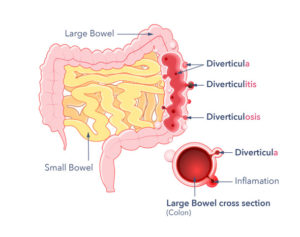Flushing away the poo taboo, together!
What is it that stops us from talking about our digestive health, or poo, as openly as we’d talk about having a cold, a headache or back pain? After all, our poo is an indication...
7th March 2024

20th April 2021
 A new review has been published about diverticulosis (in the bowel) with data from countries around the world. But before we dig deep into diverticulosis around the world, it’simportant that you know the difference between diverticulosis, diverticular disease and diverticulitis.
A new review has been published about diverticulosis (in the bowel) with data from countries around the world. But before we dig deep into diverticulosis around the world, it’simportant that you know the difference between diverticulosis, diverticular disease and diverticulitis.
A Western diet & lifestyle? This has been thought to contribute to the development of diverticulosis, but evidence that a low fibre diet causes these pouches is conflicting. For lifestyle, there are so many factors to consider.
Other possibilities: There are theories that these pouches might be related to increased pressures in the bowel (for example, straining). It may also link to differences in the connective tissues that make up the bowel wall. Some think there is a genetic component to it too.
 There seems to be an increasing number of people living with these pouches in their bowel, particularly in developed countries. Numbers also seem to be increasing for people who are under 40 years old.
There seems to be an increasing number of people living with these pouches in their bowel, particularly in developed countries. Numbers also seem to be increasing for people who are under 40 years old.
Interestingly, the site of these pouches in the bowel differs between Eastern and Western countries. In Western countries, the vast majority of people have these pouches on the left side of the bowel, but people in Eastern countries are slightly more likely to develop it on their right side. Individuals with black ethnicity are likely to have a higher number and higher spread of pouches in the right side of the bowel, compared with the left.
What is it that stops us from talking about our digestive health, or poo, as openly as we’d talk about having a cold, a headache or back pain? After all, our poo is an indication...
7th March 2024

Download printable version (337.3KB pdf) OVERVIEW You might have noticed supply issues with pancreatic enzyme replacement therapy (PERT), sometimes also called pancreatin. This situation has progressed. It has now caused some people who need PERT...
16th April 2024

What is a faecal-immunochemical test (FIT test)? You may know that the NHS offers national bowel cancer screening checks, by sending you a home kit. This home kit requires you to collect a small sample...
3rd April 2024

By submitting this form, you are consenting to Guts UK contacting you by email as detailed above. To make any changes to your preferences you can email us on info@gutscharity.org.uk or by calling us on 020 7486 0341. Your details are safe with us. Please read our Privacy Policy for more details.